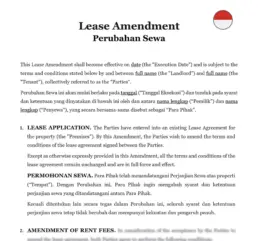Getting Started with Updating Rental Contracts
Updating rental contracts is essential for landlords to ensure their agreements remain relevant and legally compliant. Whether due to changes in laws, property updates, or new tenant requirements, revising rental contracts can help maintain clarity and protect your interests. By using professionally prepared templates, you can streamline this process and ensure all necessary updates are accurately incorporated.
For a seamless update, consider our lease amendment template. It’s designed to help you efficiently make changes while maintaining legal integrity. Explore our template to simplify your contract revisions and stay compliant with current regulations.
Review the Existing Contract
The first step in updating a rental contract is to thoroughly review the existing document. This ensures that any changes needed are identified and addressed properly.
1. Assess Current Terms
Start by evaluating the current terms and conditions of your rental agreement. Look for any clauses that may be outdated or no longer relevant. This could include sections related to rent amounts, property maintenance, or tenant responsibilities. Identifying these areas is crucial to ensure that the updated contract reflects current circumstances and needs.
2. Check for Legal Compliance
Next, verify that the existing contract complies with current local laws and regulations. Rental laws can change frequently, and it’s important to ensure that your contract aligns with any new legal requirements. This may involve updating clauses related to tenant rights, safety regulations, or rent control measures.
Regularly reviewing and updating your rental contract helps protect both your interests and those of your tenants, ensuring a fair and legally compliant agreement.
Identify Necessary Changes to update the Rental Contract
Once you’ve reviewed the existing contract, the next step is to identify and implement the necessary changes. This ensures that the updated rental agreement meets current needs and legal requirements.
| ➤ Update Legal Clauses: Modify clauses to reflect any recent changes in local, state, or federal rental laws. This might include updates related to tenant rights, eviction procedures, or rent control. |
| ➤ Ensure Compliance: Verify that the updated contract aligns with current regulations and that no legal requirements have been overlooked. This helps avoid potential legal issues. |
| ➤ Reflect Property Improvements: Update the contract to include recent property improvements or changes, such as new amenities or renovations. This ensures that all enhancements are documented and managed appropriately. |
| ➤ Revise Maintenance Responsibilities: Adjust terms related to property maintenance and repair responsibilities based on recent changes or upgrades to the property. |
| ➤ Adjust Rent Amounts: Update the rental amounts or payment schedules if there have been changes in market conditions or lease terms. |
| ➤ Modify Lease Durations: Change the lease duration or renewal terms to better fit current rental conditions or tenant needs. |
By carefully identifying and implementing these necessary changes, you ensure that your rental contract remains up-to-date and reflective of both current legal requirements and property conditions.
Draft the Updated Rental Contract
After identifying the necessary changes, the next step is to draft the updated rental contract. This process involves carefully incorporating all revisions while ensuring the document remains clear and legally sound.
When drafting the updated contract, ensure it includes all critical sections relevant to the lease. These typically cover:
1. Rent Terms: Clearly specify the updated rental amount, payment due dates, and any changes to the payment schedule.
2. Maintenance Responsibilities: Define the responsibilities for property upkeep and repairs, reflecting any recent property changes or improvements.
3. Termination Conditions: Update terms related to lease termination, renewal, or any penalties for early termination to align with current practices and legal standards.
It’s crucial to ensure that the updated contract is clear and precise. Avoid vague language and be specific about the changes being made. This clarity helps prevent misunderstandings and disputes between landlords and tenants.
By carefully drafting the updated rental contract and incorporating all necessary revisions, you ensure that both parties understand their obligations and rights.
Communicate Changes to Tenants and Implement the New Agreement
Once the updated rental contract is drafted, it’s crucial to communicate these changes effectively to your tenants and implement the new agreement smoothly. Begin by informing existing tenants about the upcoming changes. Provide them with a copy of the updated contract and clearly explain any revisions. Transparency is key to maintaining a good landlord-tenant relationship, so be prepared to address any questions or concerns they may have.
Next, formally execute the updated contract. Ensure that both you and the tenants sign the new agreement to confirm mutual understanding and acceptance of the new terms. Keep copies of the signed document for your records, and provide the tenants with their own copies. This step is essential for ensuring that the updated terms are legally binding and enforceable.
After the new agreement is in place, start applying the updated terms and conditions as outlined in the contract. Monitor compliance closely to ensure both parties adhere to the new provisions. Regularly check in with tenants to address any issues promptly and maintain open lines of communication.
ℹ️ In case of drastic changes in your lease with your tenant leading to a stoppage of your contract, consider our eviction notice letter
Ask your question and receive legal advice from a qualified lawyer
310 client reviews (4.8/5) ⭐⭐⭐⭐⭐











